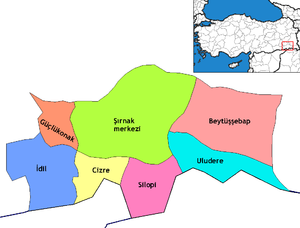İdil
İdil | |
|---|---|
| Country | |
| Province | Şırnak |
| Government | |
| • Mayor | Mehmet Muhdi Aslan (BDP) |
| • Kaymakam | Adem Kaya |
| Area | |
| • District | 1,266.10 km2 (488.84 sq mi) |
| Population | |
| • Urban | Template:Turkey district populations |
| • District | Template:Turkey district populations |
| Post code | 733xx |
| Website | www.idil.bel.tr |
İdil (Syriac: ܒܝܬ ܙܒܕܐ Beṯ Zabday or ܐܙܟ Āzaḵ, Kurdish: Hezex) is a district of Şırnak Province of Turkey. The predominant religion in the region is Islam, although it was once the home of many Assyrians belonging to the Syriac Orthodox Church and who were speakers of the Syriac language, an Aramaic dialect. Idil, part of Tur Abdin, was one of the villages that fell victim to the Assyrian Genocide or Seyfo (literally "the sword" in Syriac) from 1915-1918 (the final years of the Ottoman Empire). After the genocide, many of Idil's (or Beth-Zabday's) surviving Assyrian population was involved in a diaspora; like many of the other Assyrians and Armenians; they too fled to parts of the Middle East, Cyprus, Germany, Sweden, Holland, Canada, and the United States. Kefshenne, Hedel, Esfes, Beth Ishoq, Miden, Beth sbirino, is one of its important villages.

Azech/Beth Zabday
The Assyrian(Syriac) village of Beth Zabday (Azech). Azech was like other villages inhabited solely by Assyrian. During the AssyrianGenocide of 1915, the Azcheniye/Azchoye fought hard back and defended Christians and themselves against the overwhelming Kurdish and Turkish troops attacking the village for no other reason than to slaughter the Assyrian inhabitants. Until 1964, there were no Muslims (Kurds, Turks) in Azech. Till the beginning of the 1960s, there were no less than 3500 Assyrians living in Beth Zabday/Azech. In order to change the Assyrian Christian character and demography of the village, the Turkish state built houses and gave them to Kurds. Nonetheless until the 1977, 90% of the village was still Assyrian. In this year (1977) through fraud the Kurds, with approval from the local administration, usurped the office of the Assyrian mayor of the village Shukru Tutus, who had tried from the beginning to stop the landgrab by Kurds, and also the selling of land to Muslims. It’s stated that Anwar al-Sadat congratulated from Egypt Abdurrahman Abay for taking over the office of mayor of Azech; Anwar al-Sadat is quoted as saying: „I congratulate you to be the first Muslim who had seized/occupied Azech/Beth Zabday.” The Kurdish nomadic tribes, which were always eager for seizing Assyrian lands, began to attack more and more the village. Because of general insecurity and persecution by Kurds in these decades, including PKK terror, many Assyrians had to flee the village in the following years. In June 1994 the Assyrian mayor Shukru Tutus was murdered by Muslim Kurds, by the clan of the mentioned Abdurrahman Abay. As a direct consequence of this murder and the continuing persecution by Kurds on the one hand, and the refusal/omission of the Turkish state to protect the Assyrians on the other hand, the Assyrian inhabitants, still numbering a few hundred, fled the village. And as consequence of this Kurdish and Islamic occupation and oppression policy, today there are around 24.000 Muslims in Azech. None of them is native to Azech.
Resistance of the persecutions 1915
During the persecutions of 1915 by the Ottoman Empire (Assyrian genocide), the indigenous people of Azekh were able to resist numerous attacks.
"The Azekh Syriac Orthodox' resistance shows a more general state of mind, an authentic one indigenous to Tur Abdin. Society there was still at that time largely preserved from influences of the outside world, and was the very archetype of the traditional Syriac community with a persistently strong feeling of identity. For this reason, Azekh was one among the few villages that violently resisted the persecutions of 1915."[2]
Idil has 24,087 inhabitants (as of 2011), which are mostly Kurds, and there are Turks, Arabs and Arameans. According to the population structure is predominantly speaking Kurdish and Turkish. As a local peculiarity has in İdil under Arabic influence, a dialect of the Aramaic language developed that Azcheni. It is one of the Turoyodialekten. Speakers of this dialect now live almost exclusively outside of İdil. The inhabitants of İdil are mostly Muslims. A small portion of the population belong to the Syriac Orthodox Church.
Literature
- Sebastien De Courtois: The Forgotten Genocide: Eastern Christians, The Last Arameans, in: Tur Abdin suffers two waves of attacks, The villages of the resistance P. 34. 2004. ISBN 1-59333-077-4.
References
- ^ "Area of regions (including lakes), km²". Regional Statistics Database. Turkish Statistical Institute. 2002. Retrieved 2013-03-05.
- ^ Sebastien De Courtois: The Forgotten Genocide: Eastern Christians, The Last Arameans, in: Tur Abdin suffers two waves of attacks, The villages of the resistance S. 34. 2004. ISBN 1-59333-077-4.


